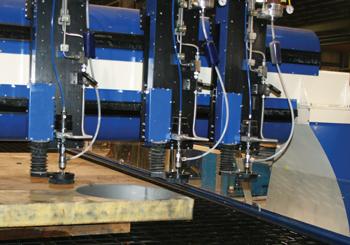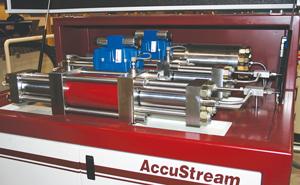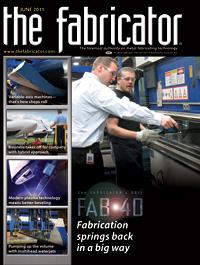Editor-in-Chief
- FMA
- The Fabricator
- FABTECH
- Canadian Metalworking
Categories
- Additive Manufacturing
- Aluminum Welding
- Arc Welding
- Assembly and Joining
- Automation and Robotics
- Bending and Forming
- Consumables
- Cutting and Weld Prep
- Electric Vehicles
- En Español
- Finishing
- Hydroforming
- Laser Cutting
- Laser Welding
- Machining
- Manufacturing Software
- Materials Handling
- Metals/Materials
- Oxyfuel Cutting
- Plasma Cutting
- Power Tools
- Punching and Other Holemaking
- Roll Forming
- Safety
- Sawing
- Shearing
- Shop Management
- Testing and Measuring
- Tube and Pipe Fabrication
- Tube and Pipe Production
- Waterjet Cutting
Industry Directory
Webcasts
Podcasts
FAB 40
Advertise
Subscribe
Account Login
Search
Three waterjet heads are better than one
Metals & Services finds that a 60,000-PSI pump works just fine
- By Dan Davis
- June 2, 2011
- Article
- Waterjet Cutting

Figure 1: The 90,000-PSI pump technology sounded intriguing to Metals & Services Co. when it was looking for new waterjet cutting capabilities, but company management realized that the strength of the water stream would be limited to one cutting head. Instead, the company elected to go with a three-head waterjet from WardJet and apply some new thinking as to how abrasive is delivered to the cutting heads. This has enabled them to maintain powerful streams of cutting power through each of the heads simultaneously.
Mark Baessler squirms at the suggestion that his family’s company, Metals & Services Co., might be a pioneer user of waterjet technology in the Midwest.
“Let’s just say it fit very well into the markets we serve,” he corrected the interviewer.
No matter what way you approach it, the fact is that the metals distribution company in Addison, Ill., has been using waterjet technology since 1999, which would definitely qualify it as an early adopter outside typical waterjet-using industries, such as aerospace. As a result, the company knows its abrasives, pumps, and nozzles better than many of its competitors and almost as well as some of the parts and technology vendors that serve them.
That type of in-depth knowledge has led Metals & Services to understand just how much of a competitive advantage its waterjet cutting capability is. The company believes that it can deliver a competitively priced part that meets the customer’s specification in a tight turnaround, and that others would be hard-pressed to match its performance. Metals & Services knows waterjets.
The latest evidence is the company’s new WardJet multihead waterjet (see Figure 1) and its 60,000-PSI pump (see Figure 2). When the fabricating industry was being barraged with news about 90,000-PSI waterjet pump technology, Metals & Services wasn’t swayed. The company did its research and found out that it could use a less powerful pump and still reach its goal of lowering its cost of equipment operations.
In the Beginning
Metals & Services opened for business in 1977. The family-owned and -operated plate processor and distributor has built a reputation for handling stainless steel and other specialty alloys. In fact, the company moved into a 250,000-square-foot facility two years ago to consolidate its activities. The company jumped into waterjet cutting in 1999.
Metals & Services tired of contracting out its waterjet work, so it purchased its own plasma/waterjet combination machine. That changed everything.
“We saw a need for customers that wanted to have near-finished parts [after cutting], and the only way you could really process shapes at that time was laser or plasma,” Baessler said. “When you laser- or plasma-cut, you are introducing an intense amount of heat to that edge; some metals crack, and other metals have hardened edges.
“So when customers want to do machining, it’s very hard on their precision equipment, and it takes a longer time to create the finished part,” he added. “With the waterjet, it can produce a finished part with no heat-affected edges and reduced material warpage.”
Of course, the waterjet cutting takes longer. That’s where the plasma torch steps in. It may harden the edge and leave a less-than-smooth edge, but the cutting head moves much faster than the waterjet’s, which translates to greater savings for customers.

Figure 2: The AS series 60,000-PSI pump from AccuStream is designed to extend component life. For instance, the hydraulic center section has an advanced piston design that helps to minimize seal wear, and a large-diameter ceramic plunger produces more water per stroke with reduced friction, also helping to extend seal life.
“Some customers only need a couple of holes or slots waterjet [cut], and the rest of it doesn’t matter,” Joe Baessler, a company engineer, said.
For example, the ID for a ring flange can be waterjet-cut, and the OD for a bolting hole can be plasma-cut, reducing the overall cost to produce the flange. That combination of technologies on one cutting table is something that has delivered real value to both Metals & Services and its customers.
“By doing the two cutting processes on the same part, we are able to reduce the cost of the part and reduce the cost to the customer,” said Mark, the company’s production manager.
The large size of the “hybrid” cutting system, as it’s called internally, keeps it constantly running. The 120- by 300-in. table is large enough to accommodate multiple plates at one time. When cutting is complete on one plate, the parts can be removed and another plate placed in its spot—all while cutting is taking place on a nearby plate.
Diving Deeper Into Waterjets
That first waterjet machine actually created a thirst for more waterjet-cut parts among the company’s customers.
“More and more customers are moving away from plasma-cut parts and wanting to spend the extra expense for waterjet-cut parts because they can reduce machining expenses,” Mark said.
Five years after purchasing the first combination plasma/waterjet cutting equipment, Metals & Services was broadening its reputation for processing stainless steel and other special alloys typically in thicknesses from 0.1875 in. to 6 in. That led to a second and third waterjet, purchased at an auction in 2003.
The increased capacity meant that the shop floor always had waterjet cutting capabilities even as maintenance was being performed on one of the units. The extra tables also gave company management more opportunities to discover the perfect balance between high cutting speeds and cost-effective equipment operation.
One example of how Metals & Services improved its own waterjet operating costs, as well as boosted its green manufacturing efforts, was the purchase of a WardPro abrasive recycling system from WardJet. The recycling device takes the used abrasive—garnet from New York state—and washes it before processing it through a screen. Abrasive that has been beaten to the point where it is ineffective as a quality cutting agent falls through the screen, to be used only as a filler agent for some other industrial product. The rest of the abrasive is dried and pumped to a silo for reuse.
Of course, cutting experience and technological know-how can take you only so far. Sooner or later new technology is needed to provide the next dramatic leap in production efficiency. In September 2010 Metals & Services purchased a new waterjet and the first of what would be two 60,000-PSI pumps from AccuStream Inc.
The new pump would be able to deliver high pressure to multiple cutting heads, whereas the much ballyhooed 90,000-PSI pump technology really delivered its full cutting capacity when using only one cutting head; cutting speeds dropped dramatically when two or three cutting heads were used. With the ability to cut similar parts simultaneously and quickly because of the multiple heads, the 60,000-PSI pump made sense.
“We elected to go with multiple heads,” Joe said.
The Cutting Edge
The performance of the new pump proved itself in a few short months. The 150 HP delivered the needed volume of water and abrasive to the multiple cutting heads. Joe estimated the pump was sending about 3.5 gallons of cutting power through, kicking up cutting speeds dramatically.
“Since we switched to this newer pump with the higher volume and higher horsepower, we have been able to reduce our cost per part, and we have been able to pass that along to our customers,” Joe said.
The new waterjet cutting table provides the company with some options for the future. The control technology could accommodate more cutting heads, but that would shrink the cutting envelope for each of the remaining cutting heads. Management also could decide to add one five-axis cutting head to the table.
Metals & Services may not want to be known as a pioneer, but it certainly has motivation to stay in front of its competition by embracing the latest waterjet technology.
About the Author

Dan Davis
2135 Point Blvd.
Elgin, IL 60123
815-227-8281
Dan Davis is editor-in-chief of The Fabricator, the industry's most widely circulated metal fabricating magazine, and its sister publications, The Tube & Pipe Journal and The Welder. He has been with the publications since April 2002.
Related Companies
subscribe now

The Fabricator is North America's leading magazine for the metal forming and fabricating industry. The magazine delivers the news, technical articles, and case histories that enable fabricators to do their jobs more efficiently. The Fabricator has served the industry since 1970.
start your free subscription- Stay connected from anywhere

Easily access valuable industry resources now with full access to the digital edition of The Fabricator.

Easily access valuable industry resources now with full access to the digital edition of The Welder.

Easily access valuable industry resources now with full access to the digital edition of The Tube and Pipe Journal.
- Podcasting
- Podcast:
- The Fabricator Podcast
- Published:
- 04/16/2024
- Running Time:
- 63:29
In this episode of The Fabricator Podcast, Caleb Chamberlain, co-founder and CEO of OSH Cut, discusses his company’s...
- Trending Articles
How to set a press brake backgauge manually

Capturing, recording equipment inspection data for FMEA

Tips for creating sheet metal tubes with perforations

Are two heads better than one in fiber laser cutting?

Hypertherm Associates implements Rapyuta Robotics AMRs in warehouse

- Industry Events
16th Annual Safety Conference
- April 30 - May 1, 2024
- Elgin,
Pipe and Tube Conference
- May 21 - 22, 2024
- Omaha, NE
World-Class Roll Forming Workshop
- June 5 - 6, 2024
- Louisville, KY
Advanced Laser Application Workshop
- June 25 - 27, 2024
- Novi, MI


























